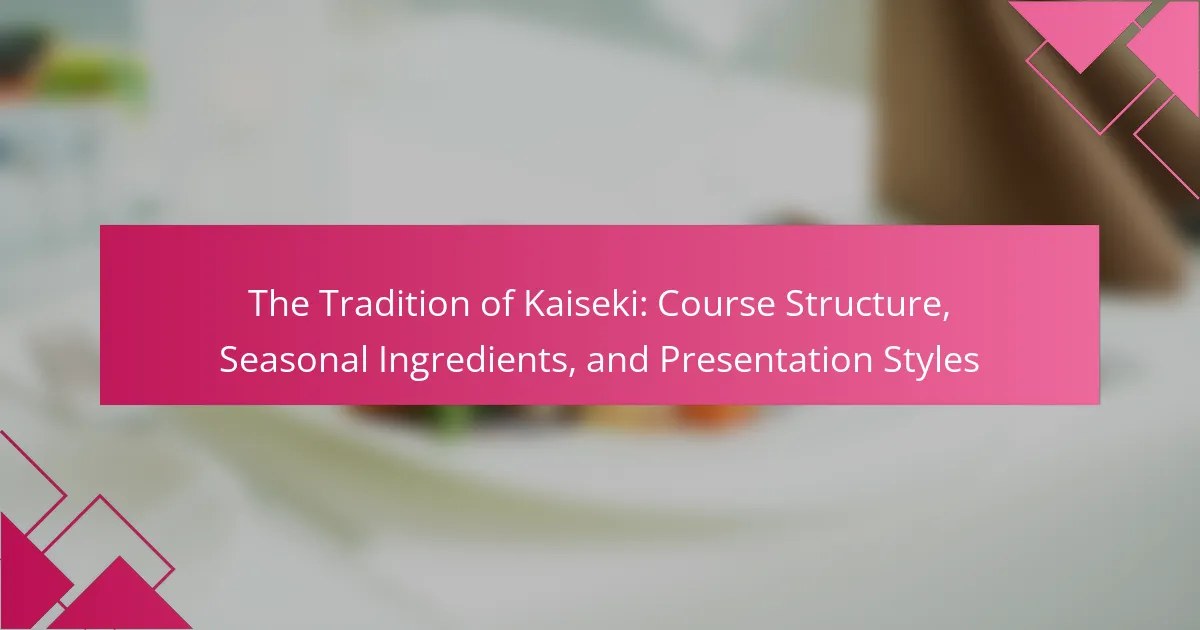
What is Kaiseki and its Historical Significance?
Kaiseki is a traditional multi-course Japanese meal that emphasizes seasonal ingredients and artistic presentation. It originated in the 16th century during the tea ceremony culture. Initially, Kaiseki consisted of simple meals served alongside tea. Over time, it evolved into a sophisticated culinary art form. Each course is carefully curated to reflect the seasons and highlight the natural flavors of the ingredients. Kaiseki is significant as it embodies Japanese aesthetics, such as harmony and balance. The meal is often served in a specific order, enhancing the dining experience. Today, Kaiseki represents Japan’s cultural heritage and culinary excellence.
How did Kaiseki evolve over time?
Kaiseki evolved from simple tea ceremony meals to elaborate multi-course dining experiences. Initially, it consisted of a single dish served during tea gatherings in the 16th century. Over time, it incorporated seasonal ingredients and refined cooking techniques. By the Edo period, Kaiseki became a formalized dining style with multiple courses. Each course was designed to highlight the flavors of the season. The presentation of the dishes also became more artistic and intricate. Today, Kaiseki is recognized as a UNESCO Intangible Cultural Heritage. This evolution reflects Japan’s cultural emphasis on harmony, nature, and aesthetics in cuisine.
What cultural influences shaped the development of Kaiseki?
Kaiseki developed from various cultural influences, primarily Zen Buddhism and the tea ceremony. Zen Buddhism emphasized simplicity and mindfulness, which shaped Kaiseki’s aesthetic and presentation. The tea ceremony introduced the concept of seasonal ingredients, aligning meals with nature’s cycles. Additionally, the influence of aristocratic dining customs contributed to Kaiseki’s refinement and complexity. Historical developments, such as the Muromachi period, further integrated these cultural elements into Kaiseki’s evolution. This blend of spiritual and social practices created a unique culinary art form that reflects Japanese culture.
How does Kaiseki reflect Japanese culinary traditions?
Kaiseki reflects Japanese culinary traditions through its emphasis on seasonal ingredients, meticulous presentation, and a structured multi-course format. This dining style showcases the principles of harmony and balance, which are central to Japanese culture. Seasonal ingredients are sourced locally, highlighting the connection to nature and the changing seasons. Each dish is thoughtfully prepared to enhance natural flavors, demonstrating the skill of the chef. The presentation of Kaiseki is an art form, with careful attention to color, arrangement, and dishware. This aesthetic aspect aligns with the Japanese value of beauty in simplicity. Kaiseki also embodies the concept of “omotenashi,” or hospitality, ensuring a memorable dining experience. Historical roots trace back to the tea ceremony, reinforcing its cultural significance. Overall, Kaiseki is a culinary expression that encapsulates the essence of Japanese traditions.
What are the core components of a Kaiseki meal?
A Kaiseki meal consists of multiple courses that highlight seasonal ingredients. The core components include sakizuke, which is an appetizer. Next is the hassun, a seasonal platter that sets the theme. The third component is the mukōzuke, typically sashimi. Then comes the nimono, a simmered dish. The fifth component is the yakimono, which is grilled fish or meat. Following that is the sunomono, a vinegared dish. The final components include the shokuji, which is rice, and the mizumono, a dessert. Each course is meticulously prepared to showcase freshness and presentation, reflecting the Japanese culinary ethos.
What is the typical course structure in Kaiseki dining?
The typical course structure in Kaiseki dining consists of multiple courses that highlight seasonal ingredients. It usually begins with an appetizer called “sakizuke.” Following this, a “tsukuri” course presents sashimi. Next, a “nimono” dish features simmered vegetables or fish. The “yakimono” course includes grilled items, often fish. A “agemono” course presents fried dishes. The meal may also include a “shokuji” course, which is rice served with miso soup and pickles. Finally, “mizumono” serves as a dessert course. This structured approach emphasizes balance, seasonal flavors, and aesthetic presentation, essential elements of traditional Kaiseki dining.
How are flavors balanced throughout the courses?
Flavors in Kaiseki are balanced through careful selection and progression of dishes. Each course is designed to complement the previous one while introducing new tastes. The meal typically starts with lighter flavors and gradually moves to richer, more intense ones. This progression avoids overwhelming the palate and enhances the dining experience. Seasonal ingredients play a key role in achieving this balance. They provide freshness and variety, allowing for a harmonious blend of flavors. The use of contrasting textures also contributes to flavor balance, as it adds depth to the overall experience. Ultimately, the careful orchestration of flavors ensures that each course is both distinct and cohesive within the meal.
What role do seasonal ingredients play in Kaiseki?
Seasonal ingredients are fundamental to Kaiseki cuisine. They enhance the dining experience by reflecting the natural cycles of the seasons. Each dish showcases ingredients that are at their peak freshness and flavor. This practice emphasizes the importance of harmony between food and nature. Seasonal ingredients also contribute to the aesthetic presentation of the meal, aligning with the visual appeal of the dishes. The use of these ingredients signifies respect for local produce and culinary traditions. Additionally, this focus on seasonality allows chefs to create menus that change throughout the year, providing diners with a unique experience each time. The commitment to using seasonal ingredients is a hallmark of authentic Kaiseki dining.
How are seasonal ingredients selected for Kaiseki dishes?
Seasonal ingredients for Kaiseki dishes are selected based on their availability and freshness. Chefs emphasize using ingredients at their peak flavor and quality. The selection process considers the changing seasons in Japan. Each season brings unique ingredients, such as cherry blossoms in spring or chestnuts in autumn. This practice aligns with the philosophy of honoring nature’s cycles. Additionally, regional variations influence ingredient choices. Local produce is often prioritized to enhance the dining experience. This commitment to seasonality reflects the cultural significance of food in Japanese cuisine.
What are some examples of seasonal ingredients used in Kaiseki?
Seasonal ingredients used in Kaiseki include fresh fish, vegetables, and fruits. For example, spring features ingredients like bamboo shoots and cherry blossoms. Summer highlights include tomatoes and cucumbers. Autumn showcases ingredients such as chestnuts and mushrooms. Winter ingredients often consist of root vegetables and fatty fish. These ingredients reflect the seasons, enhancing the dining experience. Each ingredient’s availability influences the menu, showcasing the harmony with nature. This seasonal approach is a fundamental aspect of Kaiseki cuisine.

How is Kaiseki presented and served?
Kaiseki is presented in a multi-course format that emphasizes seasonal ingredients. Each course is artfully arranged to showcase the beauty and harmony of the food. The dishes are typically served in small portions to allow for a variety of flavors. Presentation often includes traditional Japanese tableware, enhancing the visual appeal. Seasonal themes are reflected not only in the ingredients but also in the colors and arrangement of the dishes. Kaiseki meals are served in a specific order, starting with lighter flavors and progressing to richer ones. This thoughtful progression enhances the dining experience. The meticulous presentation and serving style are integral to the overall enjoyment of Kaiseki, making it a culinary art form.
What are the different presentation styles in Kaiseki?
Kaiseki features several distinct presentation styles. The styles emphasize aesthetics, balance, and seasonal ingredients. One style is called “Mizumono,” which focuses on refreshing desserts. Another style is “Tsukuri,” highlighting beautifully arranged sashimi. “Yakimono” emphasizes grilled dishes presented with care. “Nimono” showcases simmered dishes, often in elegant bowls. Each style reflects the season’s essence and the chef’s artistry. These presentation styles enhance the dining experience, making Kaiseki a visual and culinary art form.
How does presentation enhance the dining experience in Kaiseki?
Presentation in Kaiseki enhances the dining experience by creating a visual feast that reflects seasonal themes. The careful arrangement of dishes showcases artistry and attention to detail. Each course is presented in a way that highlights its ingredients and cultural significance. This visual appeal stimulates anticipation and engagement with the meal.
Moreover, the use of seasonal elements in presentation connects diners to nature and the passage of time. Traditional vessels and tableware complement the food, adding to the overall aesthetic. Studies indicate that visually appealing food can enhance perceived taste and enjoyment. Thus, presentation plays a crucial role in elevating the Kaiseki dining experience.
What utensils and dishware are traditionally used in Kaiseki?
Kaiseki traditionally uses a variety of utensils and dishware. Common items include lacquered wooden trays for serving. Small ceramic bowls are often used for soups and sauces. Additionally, flat plates made of porcelain are utilized for main dishes. Bamboo utensils may also be present for serving and eating. Each piece is chosen for its aesthetic appeal and seasonal relevance. The presentation emphasizes harmony and balance, reflecting the philosophy of Kaiseki cuisine.
Why is aesthetics important in Kaiseki dining?
Aesthetics is important in Kaiseki dining because it enhances the overall dining experience. The visual presentation of each dish reflects the season and the chef’s skill. This focus on aesthetics engages diners and stimulates their senses. Moreover, the arrangement of food is designed to create harmony and balance. Traditional Kaiseki emphasizes natural beauty, often using seasonal ingredients. This connection to nature deepens the appreciation for the meal. Studies show that visual appeal can significantly influence taste perception. Therefore, aesthetics in Kaiseki is not just decoration; it is integral to the culinary art form.
How does visual presentation impact the perception of flavors?
Visual presentation significantly impacts the perception of flavors. Aesthetic elements influence taste perception by engaging the senses before food is consumed. Research indicates that color, arrangement, and plating techniques can alter flavor expectations. For example, a study by Spence et al. (2016) found that a dish presented with vibrant colors is perceived as more flavorful. Additionally, the use of elegant plating can enhance the perceived quality of the food. This phenomenon occurs because visual cues shape our expectations and experiences with taste. Thus, well-executed visual presentation can elevate the overall dining experience by enhancing flavor perception.
What elements contribute to the overall aesthetic of a Kaiseki meal?
The overall aesthetic of a Kaiseki meal is influenced by several key elements. These elements include seasonal ingredients, presentation techniques, and the arrangement of dishes. Seasonal ingredients highlight freshness and variety, reflecting nature’s cycles. Presentation techniques focus on color, texture, and balance, creating visual appeal. The arrangement of dishes emphasizes harmony and flow, guiding the diner’s experience. Each element contributes to a multi-sensory experience that is both visually stunning and culturally significant. The aesthetic is rooted in Zen principles, promoting simplicity and mindfulness in dining.

What are the modern interpretations of Kaiseki?
Modern interpretations of Kaiseki emphasize creativity and personal expression. Chefs often incorporate global influences into traditional frameworks. This evolution allows for diverse flavor profiles and innovative presentations. Seasonal ingredients remain central to Kaiseki, reflecting the natural environment. Presentations are increasingly artistic, blurring lines between food and art. Some interpretations focus on sustainability, using locally sourced produce. Others experiment with vegetarian or vegan options, expanding accessibility. Overall, modern Kaiseki reflects a balance between tradition and contemporary culinary trends.
How have contemporary chefs adapted Kaiseki for modern tastes?
Contemporary chefs have adapted Kaiseki for modern tastes by incorporating diverse culinary influences. They often blend traditional Japanese ingredients with global flavors. This fusion creates unique dishes that appeal to a broader audience. Seasonal ingredients remain essential, but chefs now emphasize local sourcing. Presentation styles have also evolved, embracing minimalism and artistic flair. Some chefs experiment with plating techniques to enhance visual appeal. Additionally, dietary preferences, such as veganism, are now considered in Kaiseki menus. This approach allows for inclusivity while maintaining the essence of the original cuisine. Overall, these adaptations reflect a balance between tradition and innovation in modern dining.
What innovations are being introduced in Kaiseki cuisine?
Innovations in Kaiseki cuisine include the use of modern cooking techniques and global ingredients. Chefs are incorporating sous-vide methods to enhance flavor and texture. Fusion elements are emerging, blending traditional Japanese flavors with international cuisines. Seasonal ingredients are still prioritized, but there is a greater emphasis on sustainability. Plant-based options are being introduced to cater to dietary preferences. Presentation styles are evolving, with more artistic and contemporary plating. Technology, such as molecular gastronomy, is also being explored within Kaiseki. These changes reflect a dynamic adaptation of the cuisine while respecting its roots.
How does modern Kaiseki differ from traditional practices?
Modern Kaiseki emphasizes creativity and personal expression, differing from traditional practices that adhere to strict protocols. Traditional Kaiseki follows a rigid course structure with specific seasonal ingredients and presentation styles. Modern interpretations often incorporate diverse culinary techniques and global influences. Chefs today may prioritize aesthetic innovation over historical accuracy. Additionally, modern Kaiseki can be more flexible in course offerings, allowing for personalization based on diners’ preferences. This evolution reflects broader culinary trends while still honoring the core principles of Kaiseki.
What tips can enhance the Kaiseki dining experience?
To enhance the Kaiseki dining experience, focus on the presentation and seasonal ingredients. Each course should be visually appealing, reflecting the artistry of Japanese cuisine. Pay attention to the harmony of colors and textures in each dish. Engage with the chef or server to understand the ingredients and their significance. This adds depth to the dining experience. Savor each bite slowly to appreciate the flavors and craftsmanship. The traditional setting and ambiance also play a crucial role. Enjoy the meal in a serene environment to fully immerse yourself in the experience.
How should one prepare for a Kaiseki meal?
To prepare for a Kaiseki meal, one should first understand its formal nature. Kaiseki is a multi-course Japanese dining experience that emphasizes seasonal ingredients and presentation. It is essential to arrive with an open mind and a respectful attitude towards the culinary art. Dress appropriately, as this meal often takes place in a refined setting. It is advisable to refrain from heavy meals prior to the Kaiseki to fully appreciate the courses. Understanding the seasonal ingredients can enhance the experience, as Kaiseki showcases the best of what is available at that time. Familiarizing oneself with the typical structure of a Kaiseki meal can also be beneficial. This meal usually includes a variety of courses, each with its own distinct flavors and presentation styles. Engaging with the chef or staff about the dishes can enrich the dining experience.
What etiquette should be observed during a Kaiseki dining experience?
During a Kaiseki dining experience, several etiquette rules should be observed. First, guests should arrive on time, as punctuality is highly valued. Second, it is polite to express gratitude to the chef and hosts. Third, guests should wait for the host to begin the meal before starting to eat. Fourth, using chopsticks properly is essential; do not stick them upright in rice or pass food directly from chopstick to chopstick. Fifth, it is customary to savor each course and appreciate the presentation and seasonal ingredients. Lastly, guests should refrain from discussing negative topics during the meal, as Kaiseki is meant to be a harmonious experience. These practices reflect respect for the culinary art and the dining experience.
Kaiseki is a traditional multi-course Japanese meal that emphasizes seasonal ingredients, artistic presentation, and cultural significance. The article explores the historical evolution of Kaiseki from simple tea ceremony meals to a sophisticated culinary art form, highlighting its core components, typical course structure, and the balance of flavors throughout the dining experience. It also examines the role of seasonal ingredients, the importance of aesthetics in presentation, and modern adaptations of Kaiseki cuisine. Additionally, the article provides insights into etiquette and preparation for a Kaiseki meal, ensuring a comprehensive understanding of this unique dining tradition.
